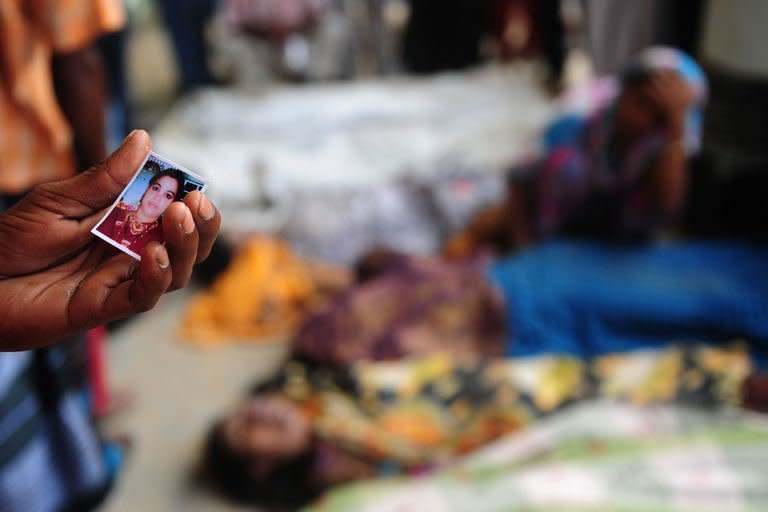Dozens found alive as Bangladesh tragedy toll hits 256
Dozens of workers were found alive Thursday as they huddled in the wreckage of a collapsed garment factory bloc in Bangladesh, a rare success for rescuers who have pulled out 256 bodies. In an announcement greeted by wild applause from thousands of relatives at the scene, an army spokesman initially announced that 40 survivors had been discovered together in a room, but the figure was later revised to 24. Earlier, the national fire service chief told AFP that 20 people had been rescued. Screams filtering through the cracks in the concrete suggested more survivors were awaiting help, but a steady stream of bodies saw the recorded death toll almost double on Thursday and hundreds remain unaccounted for. Working with floodlights and hand torches, rescuers crawled through the cracks and pulled out three woman garment workers alive from the rubble at 11.30pm Bangladesh time (1730GMT), fire service director Mahbubur Rahman said. "We've also located several pockets inside the wreckage where many people are still trapped. We could hear their screams. They're given food, water and oxygen," he told AFP, adding around 1,500 people so far have been rescued alive. The collapse of the building on Wednesday on the outskirts of the capital is the worst industrial accident in the country's history and is the latest in a spate of tragedies in the "Made in Bangladesh" clothing sector. It prompted new criticism of Western brands who were accused by activists of placing profit before safety by sourcing their products from the country despite its shocking track record of deadly disasters. Hundreds of thousands of workers walked out of their factories in solidarity with their dead colleagues on Thursday as flags flew at half mast and a national day of mourning was held. "The death toll is now 256," police sub-inspector Wali Asraf, told AFP from the disaster site, adding more bodies were being recovered and that most of those who died are female garment workers. Safety problems and poor working conditions plague the textile industry in Bangladesh, the world's second-biggest clothing exporter after China. Last November a blaze at a factory making products for Walmart and other Western labels left 111 people dead, with survivors describing how fire exits were kept locked by site managers. Only British low-cost fashion line Primark and Spanish giant Mango have acknowledged having their products made in the collapsed factory bloc, while a host of brands including Wal-Mart and France's Carrefour are investigating. A spokeswoman for Mango said the company had placed orders for at least 25,000 "sample" items. The orders were submitted between January and March, according to documents seen by AFP. Italian fashion line Benetton denied having a supplier in the building but a local workers' group provided documents showing apparent orders from the company in August and September last year. The company did not reply to repeated requests from AFP for comment. Survivors said the building developed visible cracks on Tuesday evening, but factory bosses had demanded staff return to the production lines despite a police evacuation order. One manager for the New Wave Styles company, one of the five manufacturers in the building, told how the owner had consulted an engineer but then ignored his warnings. "Those who're involved, especially the owner who forced the workers to work there, will be punished," Prime Minister Sheikh Hasina told lawmakers. "Wherever he is, he will be found and brought to justice." Home minister Muhiddin Khan told reporters the eight-storey building, allegedly owned by a ruling party official, did not have valid construction permits. Police filed a case accusing the owner of death due to negligence. At the scene of the disaster, relatives desperate for news descended in their thousands, clutching photographs and hoping to see their missing loved ones pulled out by firemen and soldiers. "I became so thirsty that at one stage I drank my urine," said an ecstatic Abul Hossain, 23, as he was dragged from the ruins more than 25 hours after the disaster struck at around 09:00 am (0300 GMT) on Wednesday. But others were less lucky, with body after body laid out on the grounds of a nearby school for identification. "I've seen all the bodies. My sister was not among them. She is also not in any of the hospitals," said Mukta Begum, holding the photo of her younger sibling Suryaban, a garment worker. Babul Akhter, head of the Bangladesh Garments and Industrial Workers Federation, told AFP that the factory owners -- who have gone into hiding -- would likely escape justice despite the outcry. "Garment entrepreneurs are above the law here. There is hardly any example of an owner being prosecuted for this kind of outright murder," he said. "The Western retailers are also complicit because they give a blind eye to the manufacturers' shoddy practices." Before the 24 were found national fire service chief Ahmed Ali said 20 people had been rescued, adding that he thought more would be saved.





